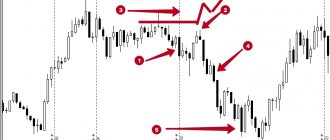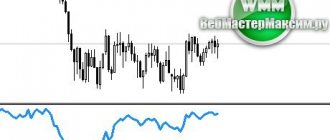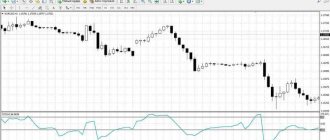What is support and resistance
Support level is a level located below (at the lows) of the price, the zone from which the price movement most often reverses upward.
Resistance level is a level located above (at the highs) of the price, the zone from which the price movement most often reverses downward.
Simply put, this is the level from which the price most often bounced by a certain number of points. For example, for the GBP/USD currency pair in the screenshot below you can see how the price struggled in one range and bounced off it several times, after which the resistance zone was broken, after which it became a new support level.
This can happen for several reasons:
1) There are no requests to open orders above this level.
2) At this level there are large volumes of open positions against the movement.
For example, on the red line, one of the large traders (banks) held many open positions for sale and buyers were unable to overcome their volume and therefore there was a rollback from the resistance level.
Calculation of the indicator
To find the trend line, the True Strength Index is used, which is calculated using the following formula:
Formula for calculating the indicator
EMA is an exponential average;
Momentum – the difference in the prices of today's and yesterday's closing transactions;
N – number of periods required for smoothing.
The use of the TSI indicator is available after downloading a special program to a personal computer. This indicator is supported by reliable technical support, so there are no failures in using the program.
Optimization of operating parameters
Installing the software is convenient and simple. Even an inexperienced user can easily cope with the optimization of such an algorithm. After downloading, you will need to activate the algorithm. After this, a special window will appear on the monitor screen, in which you can configure all the parameters. For successful setup, you should familiarize yourself with the main fields of the window.
“First-R” is a parameter that allows you to determine the moving average. This indicator is necessary in order to initially smooth out the algorithm's curve. Experts recommend setting this field to the default value of 5. Such conditions will maximize the success of upcoming auctions.
“Second-S” is an indicator responsible for setting the second moving average. It smoothes the algorithm curve a second time and allows you to average the results for a better user experience. It is recommended to set this field to 8. This will reduce the risk of receiving data with a large error and increase the chances of conducting a successful transaction.
As you can see, the algorithm has only two parameters. This is why TSI settings are suitable for both beginners and experienced traders. By the way, the latter can use the financial instrument in conjunction with other strategies and programs.
Even the default settings can ensure correct operation on the stock market. This allows you to reduce the time for optimizing parameters before starting trading. The main advantage of this oscillator is that it can be successfully used even without any knowledge of the laws of trading.
Features of using the algorithm
The Real Strength Index is an oscillator, so it should be considered from the point of view of this category of financial instruments. When analyzing overbought/oversold conditions, you need to effectively use this strategy. Conditions must be met under which the price moment is located precisely in this area. To achieve maximum accuracy in determining overbought/oversold conditions, it is worth using special parameters - 25 and 13, respectively.
In this case, you should pay attention to the window with levels. Here you need to set the values – 25 and -25. It is better to refrain from transactions if the red line falls below the white line on the chart. When the market is overbought, the algorithm curve is located at around 25. When the curve is near the -25 mark, we can talk about the market being oversold.
Signals of the second type are also determined using this financial instrument. The indicator is also used to determine the most appropriate moment when creating a trading position. It is recommended to start creating a buy order the moment the chart crosses the lower mark of -25. You should start thinking about selling when the algorithm passes the -25 mark at the top.
Additional features
Also, taking into account the capabilities of various Forex advisors, you can determine the signals for carrying out a transaction. When the curve crosses the zero mark, then the moment comes to open an order. Before this, you must go to the settings and set parameters 5 and 8 (described above in optimization).
In this case, the analysis of divergences must be carried out by first marking the zero value in a special window. It is best to make a purchase when the chart crosses the zero mark from below. Accordingly, a sell order is created when the zero mark is passed at the top of the chart.
The described method is recommended to be used as part of a Forex trading strategy. Despite this, many traders consider this financial instrument as an excellent option for opening new positions.
Using a demo account
The great news for beginners is that you can try this oscillator using a demo account. Even if you are an experienced trader, but using such methods for the first time, the test version of the program will be a good way to eliminate the risks of monetary losses.
The indicator will help determine the difference between the current price and the order value in the past. This opportunity is very attractive for users who are accustomed to creating their own analytics to enter the market. Experts recommend using real money only after gaining the skills to work on a demo account.
Japanese candles and their uses
Japanese candles
Japanese candles have achieved great popularity due to their simplicity and ease of use. This method is truly an advanced financial tool that allows you to predict market trends.
Japanese candlesticks inspire more confidence among those traders who are not too lazy to look into history. The fact is that this approach began to be successfully used back in the 17th century. Despite such archaism, the financial instrument is still actively used today, but taking into account the capabilities of modern technologies and methods of analyzing the market situation.
It is worth noting that a candlestick chart has many advantages over a traditional line chart. Based on many years of research, special algorithms have been developed that classify the combination of candles and give traders the opportunity to quickly make decisions based on simple graphic combinations.
Benefits of Japanese candles
This method of graphical analysis includes the following advantages:
- maximum information content;
- ease of perception;
- the ability to conduct a comprehensive analysis of the market situation;
- availability of key indicators.
Japanese candlesticks allow you to almost instantly identify the most complex graphical patterns. This task takes significantly longer to complete when using traditional line charts.
In technical analysis, the Japanese candlestick method plays one of the leading roles.
Today, traders from all over the world successfully use modernized financial instruments based on the principle of Japanese candlesticks from the 17th century. A competent approach to the integrated use of indices ensures maximum profit multiplication even for an inexperienced Forex market participant.
Trading using levels
Trading using support and resistance levels can be very successful; many traders use these levels in their trading for a long time.
Remember a few basic rules:
- Open a sell trade when the price reaches the resistance level.
- Open a buy deal when the price reaches the support level.
- The price does not always have to touch the support/resistance level; if it has not reached it by 1-10 points, then you can open a position.
- Use stop losses, they can be set 20-30 points beyond the line, depending on your timeframe.
The most difficult task is finding the levels correctly, which is why below you will find indicators for automatically finding support and resistance levels.
You can read in more detail about how to correctly build levels manually and trade on them.
Features of the short-term trend indicator
The Trend Strength indicator works with tick history, i.e., after switching on, current ticks are processed and calculated values are displayed. This method of obtaining information makes it independent of the chart timeframe. Trend Strength does not use third-party indicators and does not redraw charts. With the correct settings, the indicator informs with a sound signal about the occurrence of the expected event. Can also send notifications by email.
The short-term trend analysis tool was designed for scalping, in which traders catch tiny price spikes on one- and five-minute charts. The indicator allows you to work on other timeframes. With its help, you can see the beginning and end of a trend in the market. If you open positions after catching a strong movement, you can get quite high profits. The chain looks like this: the stronger the trend, the longer it will last, the more difficult it is to reverse it, the more insignificant the corrections and the more earnings.
Settings
- BackLimit — maximum number of bars to be analyzed
- TimeFrame - the period from which the levels will be calculated (0 - current, 60-hour, 1440 - 4 hours, etc.)
- Color_ — line colors, you can change them at your discretion
- Zone_show_weak - display weekly levels
- Zone_fuzzfactor - Fuzz factor (level filtering)
- Zone_solid — true/false — filling the zone with color
- Zone_linewidth — thickness of levels
- Zone_Showinfo — information about zones (broken, tested, not broken)
- Zone_Alerts - signal when a new zone or breakout appears
Trading signals by strategy
In the normal state of the indicator, the yellow line is in the middle - between purple and blue. However, when a trading signal appears, it goes beyond the boundaries of this channel, ending up at the top or bottom.
A downward signal is the appearance of a yellow line at the bottom of all the others, as well as the transition of the blue line to the lowest position.
A signal to increase is the exit of the yellow line on top of all the others, combined with the intersection of the purple and blue lines, as a result of which the latter goes up.
If you look closely at the indicator, it is easy to notice that in most cases the yellow curve is not visible; it is hidden behind the other two lines. If it becomes noticeable in the middle of the channel, then this signals high market volatility. When it goes beyond it, it indicates the approach of a trading signal.
Settings
- Showinfo — true/false show information on the chart about levels and settings
- Autoset - automatic setting of parameters
- showlines — show vertical lines (formation points)
- TimeFrame1 - the first timeframe on which the lines will be drawn
- TimeFrame2 - the second additional timeframe on which the lines will be drawn
- TimeFrame3 - the third additional timeframe on which the lines will be drawn
Egor Belyaev / author of the article
Financial analyst. Prefers to work in the foreign exchange market. 6 years trading experience. Expert of the site ForexGid.Ru.











